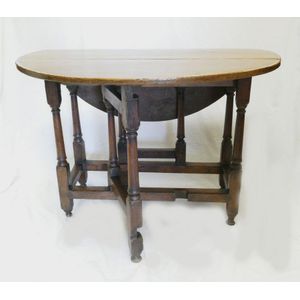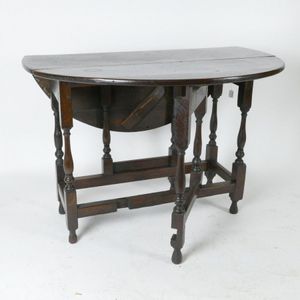18th Century English Oak Gate Leg Dining Table
You must be a subscriber, and be logged in to view price and dealer details.
Subscribe Now to view actual auction price for this item
When you subscribe, you have the option of setting the currency in which to display prices to $Au, $US, $NZ or Stg.
- Turning - Any part of a piece of furniture that has been turned and shaped with chisels on a lathe. Turned sections include legs, columns, feet, finials, pedestals, stretchers, spindles etc. There have been many varieties and fashions over the centuries: baluster, melon, barley-sugar, bobbin, cotton-reel, rope-twist, and so on. Split turning implies a turned section that has been cut in half lengthwise and applied to a cabinet front as a false decorative support.
- Oak - Native to Europe and England, oak has been used for joinery, furniture and building since the beginning of the medieval civilisation. It is a pale yellow in colour when freshly cut and darkens with age to a mid brown colour.
Oak as a furniture timber was superceded by walnut in the 17th century, and in the 18th century by mahogany,
Semi-fossilised bog oak is black in colour, and is found in peat bogs where the trees have fallen and been preserved from decay by the bog. It is used for jewellery and small carved trinkets.
Pollard oak is taken from an oak that has been regularly pollarded, that is the upper branches have been removed at the top of the trunk, result that new branches would appear, and over time the top would become ball-like. . When harvested and sawn, the timber displays a continuous surface of knotty circles. The timber was scarce and expensive and was used in more expensive pieces of furniture in the Regency and Victorian periods. - Turned Legs - are legs which have been turned on a lathe. In use from the 16th century, turned legs on tables, chairs and cabinets became more frequent until, by the 1830s, the Georgian square or tapered leg was rarely found except in country pieces.
This item has been included into following indexes:
-
tables, large dining
- dining, fixed tops, English 432
- gateleg 156
Visually similar items

An oak gate leg dining table 137 cm

A George II/III country oak drop-side gate leg table, rule joints, oval when extended, plank pegged construction, matching turned supports, good old wear to the base rails, turned turnip type feet. Original drawer to one end. 31 x 147 x 75 cm

A Georgian oak gate leg table, the plain circular four plank top supported on traditional turned leg stretcher base. Good colour and patina. The single drawer at one end has been replaced. Diameter 95 cm, height 68 cm

A George III country oak gate-leg table, the circular top of four panels when extended, restrained turned legs and plain stretchers, pegged construction, good dark patina. 100 cm x 102 cm x 71.5 cm.
